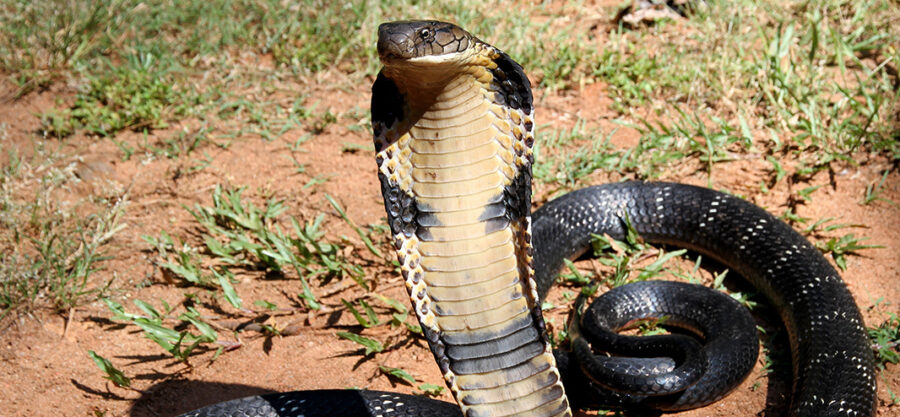
Due to its size, temperament, venom, and overall reputation, the king cobra (not a true cobra, by the way) is a snake to be respected and feared. These snakes are more closely related to mambas than to cobras. Kings are the largest known venomous snake in the world. A few things differ in kings from that of true cobras. 1 is a narrower hood, another is a smaller head size, and king cobras also have occipital scales at the base of the neck. They can be found in India, China, the Philippines, Indonesia, Bangladesh, Cambodia, Myanmar, Thailand, Vietnam, and the Malay Peninsula. These snakes prefer highland forests covered in dense bush, mangrove swamps, bamboo thickets, rainforests, and agricultural settlements. Kings prefer to dwell near bodies of water. Due to habitat destruction, these large snakes are listed as Vulnerable by the IUCN.
First the Stats…
Scientific name: Ophiophagus hannah
Weight: Up to 13 lbs.
Length: Up to 18+ feet
Lifespan: Up to 20 years
Now on to the Facts!
1.) They primarily prey on other snakes, whether they are venomous or not. Theses giants will also eat birds, small mammals, and rodents; if snakes aren’t available.
2.) If threatened, these snakes will raise their heads up to 6 feet off the ground, expand their hood, and even growl. They achieve this growling sound by breathing in and quickly exhaling the air through their tracheal diverticula, located in their respiratory tract. This makes a noise that sounds like an angry dog.
3.) King cobras have good eyesight that allows them to see movement up to 330 feet away.
4.) Kings are diurnal (active during the day).
5.) When snake charmers play their flute to get the snakes to come out of the basket, it’s not the sound of the flute that attracts the snake, as all snakes are deaf. It is the movement of the person playing the instrument.
But wait, there’s more on the king cobra!
6.) During mating season, males will wrestle one another for breeding rights. They will raise their heads up to 4 feet off the ground and take turns trying to pin the other to the ground. The first one pinned leaves. There is no biting involved, since these snakes are immune to their own venom.
7.) With just 1 bite king cobras can inject up to 1.5 teaspoons of venom into their victim!
Did you know…?
King cobra venom stops networking between nerve cells, which causes blurred vision, extreme dizziness, and paralysis. The correct antivenom has to be dosed quickly or a victim can die within 30 minutes! Their venom is so strong that 1 bite can kill a 12,000 lb. elephant in only 3 hours!
8.) King cobras are oviparous, laying up to 40 eggs at a time.
9.) Decaying leaf matter incubates the eggs and they are watched over by both parents.
10.) Just like other snakes, the king cobra takes in chemicals via its forked tongue, which picks up scent particles & transfers them to a special sensory receptor, called a Jacobson’s organ, located in the roof of its mouth. It analyzes these chemicals to determine threat or prey.
But wait, there’s still more on the king cobra!
11.) Their fangs are up to a half inch long and not retractable.
12.) They are semi-arboreal (spend part of their lives in trees) and have been spotted up to 65 feet off the ground, in trees.
Now a Short King Cobra Video!
Also, check out the Critter Science YouTube channel. Videos added frequently!
Want to suggest a critter for me to write about? Let me know here.



